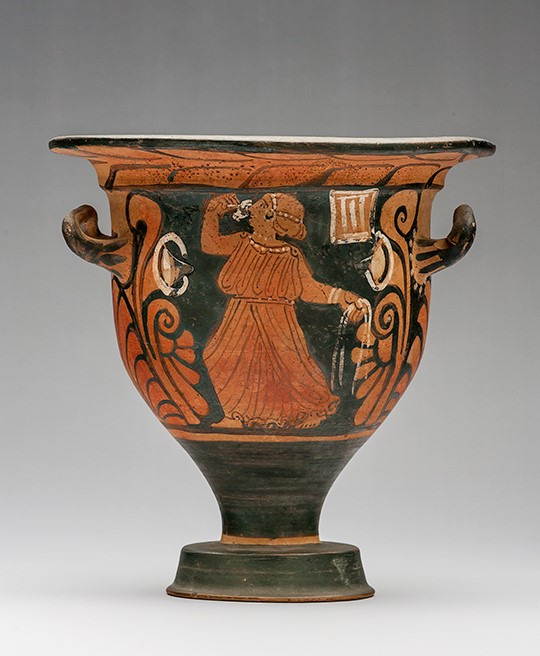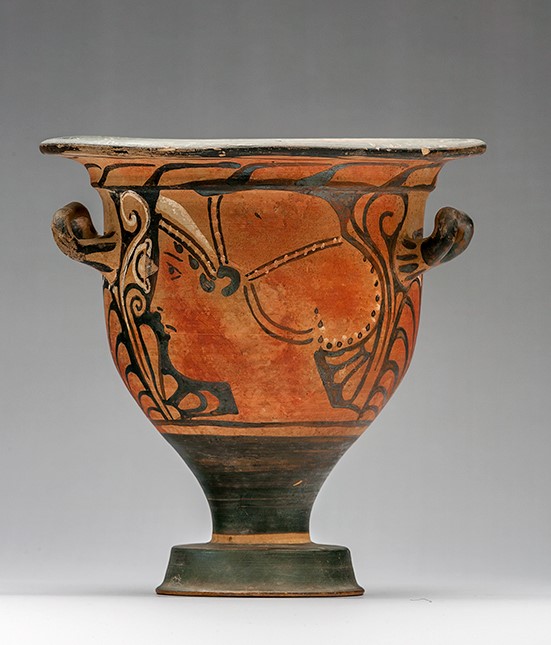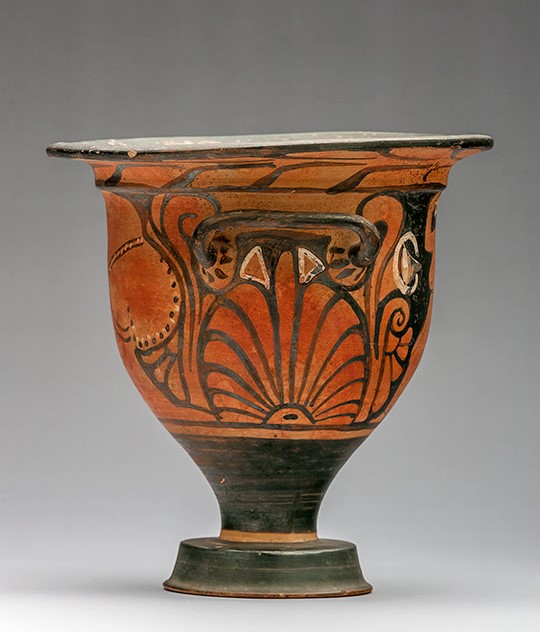Acquisition number: 1967.10
A: A woman walking left and sniffing a flower which she holds in her right hand; in her left hand she holds two fillets. In the field upper right, a window. White was added for a row of dots decorating the top of her chiton, for the dots on the sakkos on her head, her necklace, her bracelet, the flower and fillets, and on the window.
B: Female head, left, with the hair bound up in a sakkos. White was added to decorate the sakkos.
Below the handles are palmettes enlivened with added white. The bellflowers to either side of the scene on A and to the left on B are outlined in white. There are also white dots about the root of the right handle. On the lip is a band of laurel. There is a reserved band at the bottom of the stem between body and foot; the underside is reserved.
Title: Bell-Krater - 1967.10
Acquisition number: 1967.10
Attribution: Atella Painter.
Author or editor: J.R. Green
Culture or period: Campanian Red-Figure.
Date: Late 4th century BC.
Material: Clay - Terracotta
Object type: Pottery - Red-figure
Dimensions: 192mm (w) × 196mm (h)
Origin region or location: Italy
Origin city: Campania.
Display case or on loan: 8
Keywords: Campanian, Red Figure, Atella Painter
Sotheby (London), Sale Cat., 24 April 1967, no. 155; A.D. Trendall, The Red-figured Vases of Lucania, Campania and Sicily Suppl. i (London 1970) 61, no. 893b, pl. 14, 1-2; J.R. Green with B. Rawson, Catalogue of Antiquities in the Australian National University, A.N.U. (Canberra, 1981) 67.
1967.10
Bell-Krater
Presented by Professor A.D. Trendall; formerly in the Fienga collection, Nocera, no. 616. Ht 19.6cm; diam. 19.2cm.
Intact. Somewhat metallic black glaze; the reserved areas have strong reddening over the characteristically pale clay. The handles are noticeably thin.
A: A woman walking left and sniffing a flower which she holds in her right hand; in her left hand she holds two fillets. In the field upper right, a window. White was added for a row of dots decorating the top of her chiton, for the dots on the sakkos on her head, her necklace, her bracelet, the flower and fillets, and on the window.
B: Female head, left, with the hair bound up in a sakkos. White was added to decorate the sakkos.
Below the handles are palmettes enlivened with added white. The bellflowers to either side of the scene on A and to the left on B are outlined in white. There are also white dots about the root of the right handle. On the lip is a band of laurel. There is a reserved band at the bottom of the stem between body and foot; the underside is reserved.
Later fourth century BC. Attributed by Trendall to the Atella Painter, one of the two main members of the Capuan school of vase-painting towards the final stages of Campanian red-figure. The angular drawing of the woman’s knee and the schematic folds of her chiton are typical of the painter’s style. See A.D. Trendall, The Red-figured Vases of Lucania, Campania and Sicily i-ii (Oxford 1967) 349-356 with additions in The Red-figured Vases of Lucania, Campania and Sicily Suppl. i (London 1970) 61-62 and Suppl. ii (London 1973) 207-208; A.D. Trendall, The Red Figure Vases of South Italy and Sicily. A Handbook (London 1989) 162.
It is arguable that the window has a funerary significance rather than being symbolic of the woman’s situation within the house: see H. Cassimatis, “Fenêtre de l’au-delà dans l’iconographie italiote”, Melanges d’Archéologie et d'Histoire - Antiquité 107, 1995, 1061-1092. Note also M. Halm-Tiserant, “Exo - Entos. De l'ambiguïté des portes et des fenêtres dans la peinture de vases grecque”, Revue des Études Anciennes 97, 1995, 473-503.
Sotheby (London), Sale Cat., 24 April 1967, no. 155; A.D. Trendall, The Red-figured Vases of Lucania, Campania and Sicily Suppl. i (London 1970) 61, no. 893b, pl. 14, 1-2; J.R. Green with B. Rawson, Catalogue of Antiquities in the Australian National University, A.N.U. (Canberra, 1981) 67.



